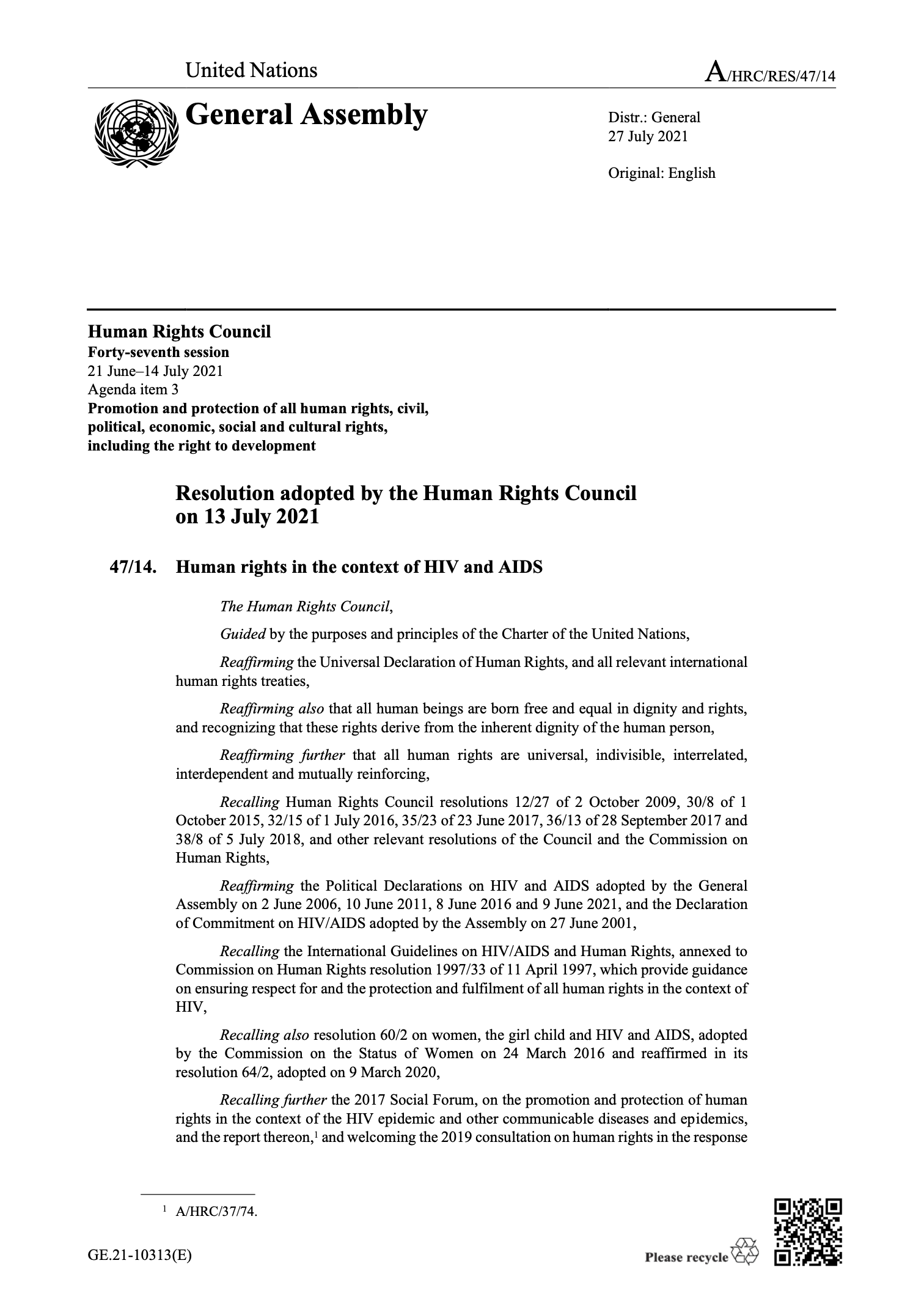2021 HRC resolution on human rights in the context of HIV and AIDS
Analysis of precedential value
This UN Human Rights Council (HRC) resolution was adopted by a recorded vote of 42 to 0, with 5 abstentions, in July 2021. This document was co-drafted by representatives of 25 Member States, 22 of which were not members of the sitting HRC.
The HRC is composed of elected representatives from 47 Member States; together, they are responsible for coordinating investigations of and responses to human rights violations.
Used as precedent
access to health products
“Urges States to bring their laws, policies and practices, including their strategies for implementing the HIV- and other health-related Sustainable Development Goals, fully into compliance with their obligations under international human rights law, and to review or repeal those that are discriminatory or that adversely affect the successful, effective and equitable delivery of, and access to, HIV prevention, diagnosis, treatment, care and support programmes for all persons living with, presumed to be living with, at risk of or affected by HIV, including key populations.” (paragraph 7)
human rights
“Affirms that respect for and the protection and fulfilment of human rights in the context of HIV, including universal access to HIV-related prevention, diagnosis, treatment, care and support, are an essential element in achieving the full realization of the right of everyone to the enjoyment of the highest attainable standard of physical and mental health and in ending AIDS.” (paragraph 1)
key and vulnerable populations
“Calls upon States to address the inequities and vulnerabilities faced by children affected by or living with HIV, providing those children and their families with social protection, support and rehabilitation, including social and psychological rehabilitation and care, paediatric services and medicines, free from stigma and discrimination, and intensifying efforts to eliminate vertical transmission and to develop and provide early diagnosis tools, child-friendly medicine combinations and new treatments for children, particularly for infants living in resource-limited settings, and building, where needed, and supporting social security systems that protect them.” (paragraph 14)
gender norms and stereotypes
“Urges States to eliminate all forms of sexual and gender-based violence, including intimate partner violence, by adopting and enforcing laws, changing gender stereotypes and negative social norms, perceptions and practices, and providing tailored services that address multiple and intersecting forms of discrimination and violence faced by women living with, at risk of or affected by HIV.” (paragraph 13)
positive legal determinants
“Calls upon States to end impunity for human rights violations and abuses against persons living with, at risk of or affected by HIV by meaningfully engaging and ensuring access to justice for them, providing legal literacy programmes, increasing their access to legal support and representation, and expanding sensitization training for judges, law enforcement officers, health-care workers, social workers and other duty bearers.” (paragraph 9)
universal health coverage
“Urges States to accelerate the integration of HIV services into universal health coverage and resilient health and social protection systems, and to ensure full and unimpeded access for all persons living with, presumed to be living with, at risk of or affected by HIV, including key populations, to HIV prevention, diagnosis, treatment, care and support, in a public health environment free from discrimination, harassment or persecution against those seeking HIV-related services, while respecting and protecting their right to privacy, confidentiality and free and informed consent.” (paragraph 5)
societal enablers
“Requests the United Nations High Commissioner for Human Rights to prepare a report, in consultation with Governments, civil society, community-led organizations and other stakeholders, describing the action being taken and recommending action to be intensified or initiated to meet the innovative targets on societal enablers, as recognized in the Political Declaration on HIV and AIDS adopted by the General Assembly in 2021, and to address the remaining gaps, and to present the report to the Human Rights Council at its fiftieth session.” (paragraph 31)
